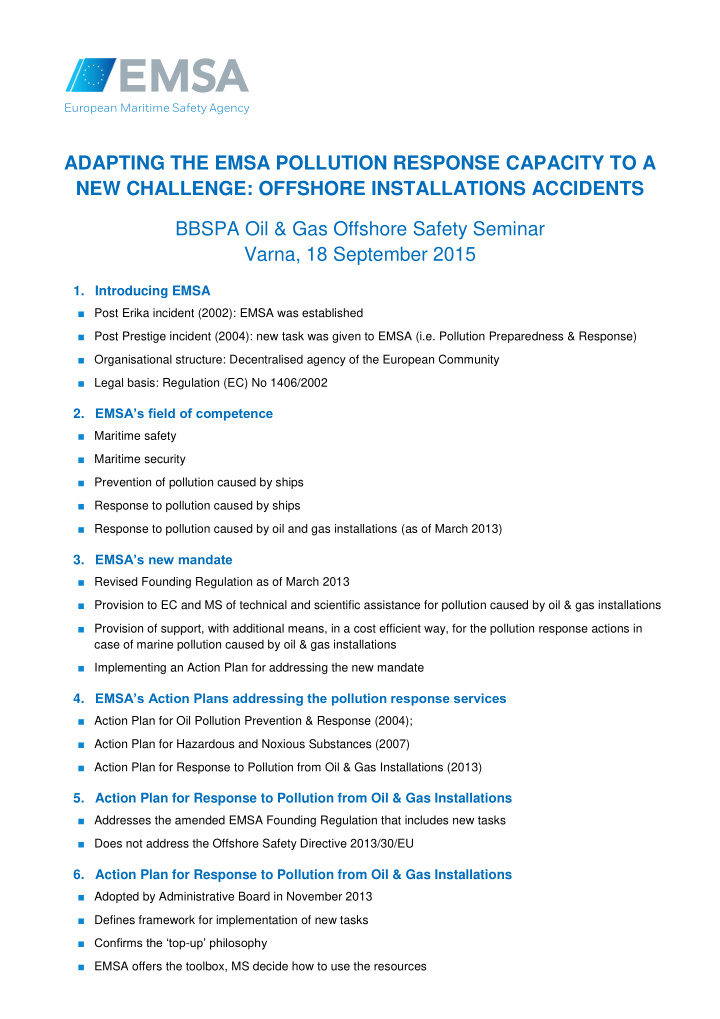



ADAPTING THE EMSA POLLUTION RESPONSE CAPACITY TO A NEW CHALLENGE: OFFSHORE INSTALLATIONS ACCIDENTS BBSPA Oil & Gas Offshore Safety Seminar Varna, 18 September 2015 1. Introducing EMSA ■ Post Erika incident (2002): EMSA was established ■ Post Prestige incident (2004): new task was given to EMSA (i.e. Pollution Preparedness & Response) ■ Organisational structure: Decentralised agency of the European Community ■ Legal basis: Regulation (EC) No 1406/2002 2. EMSA’s field of competence ■ Maritime safety ■ Maritime security ■ Prevention of pollution caused by ships ■ Response to pollution caused by ships ■ Response to pollution caused by oil and gas installations (as of March 2013) 3. EMSA’s new mandate ■ Revised Founding Regulation as of March 2013 ■ Provision to EC and MS of technical and scientific assistance for pollution caused by oil & gas installations ■ Provision of support, with additional means, in a cost efficient way, for the pollution response actions in case of marine pollution caused by oil & gas installations ■ Implementing an Action Plan for addressing the new mandate 4. EMSA’s Action Plans addressing the pollution response services ■ Action Plan for Oil Pollution Prevention & Response (2004); ■ Action Plan for Hazardous and Noxious Substances (2007) ■ Action Plan for Response to Pollution from Oil & Gas Installations (2013) 5. Action Plan for Response to Pollution from Oil & Gas Installations ■ Addresses the amended EMSA Founding Regulation that includes new tasks ■ Does not address the Offshore Safety Directive 2013/30/EU 6. Action Plan for Response to Pollution from Oil & Gas Installations ■ Adopted by Administrative Board in November 2013 ■ Defines framework for implementation of new tasks ■ Confirms the ‘top - up’ philosophy ■ EMSA offers the toolbox, MS decide how to use the resources
7. Adaptation of existing services / tools ■ Network of Stand-by Oil Spill Response Vessels ■ Experts (on-site / office-based) ■ CleanSeaNet and illegal discharges 8. Network of SOSRVs ■ Technical adaptation ■ Contractual adaptation ■ Geographical adaptation Map with the current distribution of EMSA’s oil spill recovery vessels 9. 10. Monitoring & evaluation tools ■ Relocation of available images if requested by MS (no extra satellite images) ■ More info on location of oil & gas installations ■ Information more accessible to relevant authorities 11. Provision of additional pollution response services / tools ■ Limited quantities of dispersant ■ Seaborne dispersant application services ■ Airborne dispersant application services ■ Stand-alone equipment 12. Provision of dispersant and application systems ■ Limited quantities of dispersant ■ 2-3 vessel dispersant spraying arrangements ■ 1-2 aerial dispersant application arrangements 13. Latest developments with regard to dispersant ■ 2 operational vessel dispersant spraying arrangements and one more arrangement in preparation (operational in Q1 2016) ■ 2 operational dispersant depots, 200 tonnes each, and one depot in preparation (operational in Q1 2016) 14. Provision of specialised equipment ■ Growing interest of MS for access to stand-alone equipment ■ Technical definition undertaken with MS experts ■ Volume of equipment dependent on available financial resources 15. Latest developments with regard to equipment ■ Equipment assistance service currently being set-up ■ One ongoing tender for storage, maintenance and mobilisation of purchased equipment
16. Latest developments with regard to equipment ■ One ongoing tender for purchase of specialised equipment not often available in/to MS 17. EMSA’s pollution response toolbox ■ Overview of EMS A’s latest pollution response capabilities 18. Framework for provision of EMSA’s pollution response services ■ ‘Top - up’ of MS capabilities ■ European tier of resources ■ Mobilisation by EMSA following request of EU/EFT MS or the Commission ■ Mobilisation channelled through ‘EU Community Mechanism’ ■ Under ‘operational control’ of the requester, EMSA only offers the toolbox 19. Framework for provision of EMSA’s pollution response services (latest developments) ■ Updated ‘EMSA Mobilisation User Guide’ (more user -friendly, bett er addressing use of EMSA’s toolbox) ■ Development and phasing- in of the EMSA ‘Guidelines for authorising the use of EMSA’s pollution response services by a Responsible Party’: granting access to EMSA’s toolbox to ship owners, oil and gas industry operators or their contractors ■ Development and phasing- in of the EMSA ‘Guidelines for authorising the use of EMSA’s pollution response services by a Third Country’ 20. How to request EMSA services: Key actors ■ Presentation of the mobilisation diagram 21. How to request EMSA services: Communication tools ■ CECIS ■ Other means of communication available to ‘third countries’ 22. Emergency Response Coordination Centre (ERCC) ■ Overview and contact details of DG ECHO’s ERCC centre for the countries participating in the Civil Protection Mechanism 23. EMSA’s Support Service (MSS) ■ Overview and contact details of EMSA’s MSS centre for maritime emergencies 24. Areas of interaction with the oil & gas industry ■ Joint exercises on pollution response ■ Exchange of information, best practices and know-how ■ Support with pollution response services/tools in case of an emergency
Recommend
More recommend